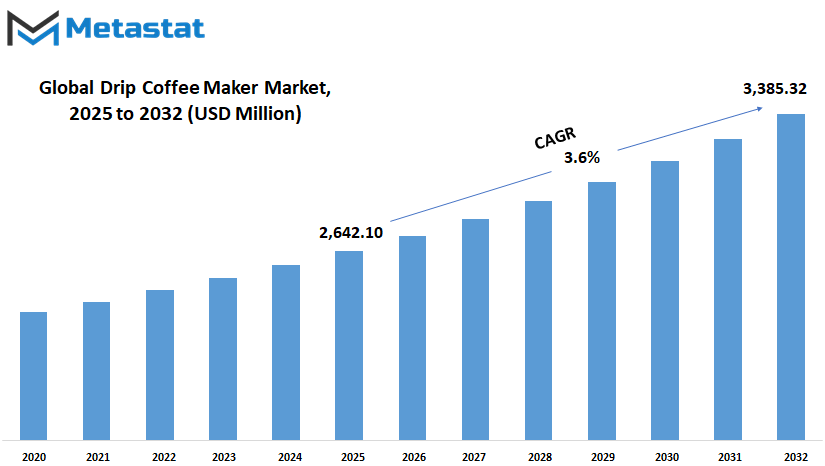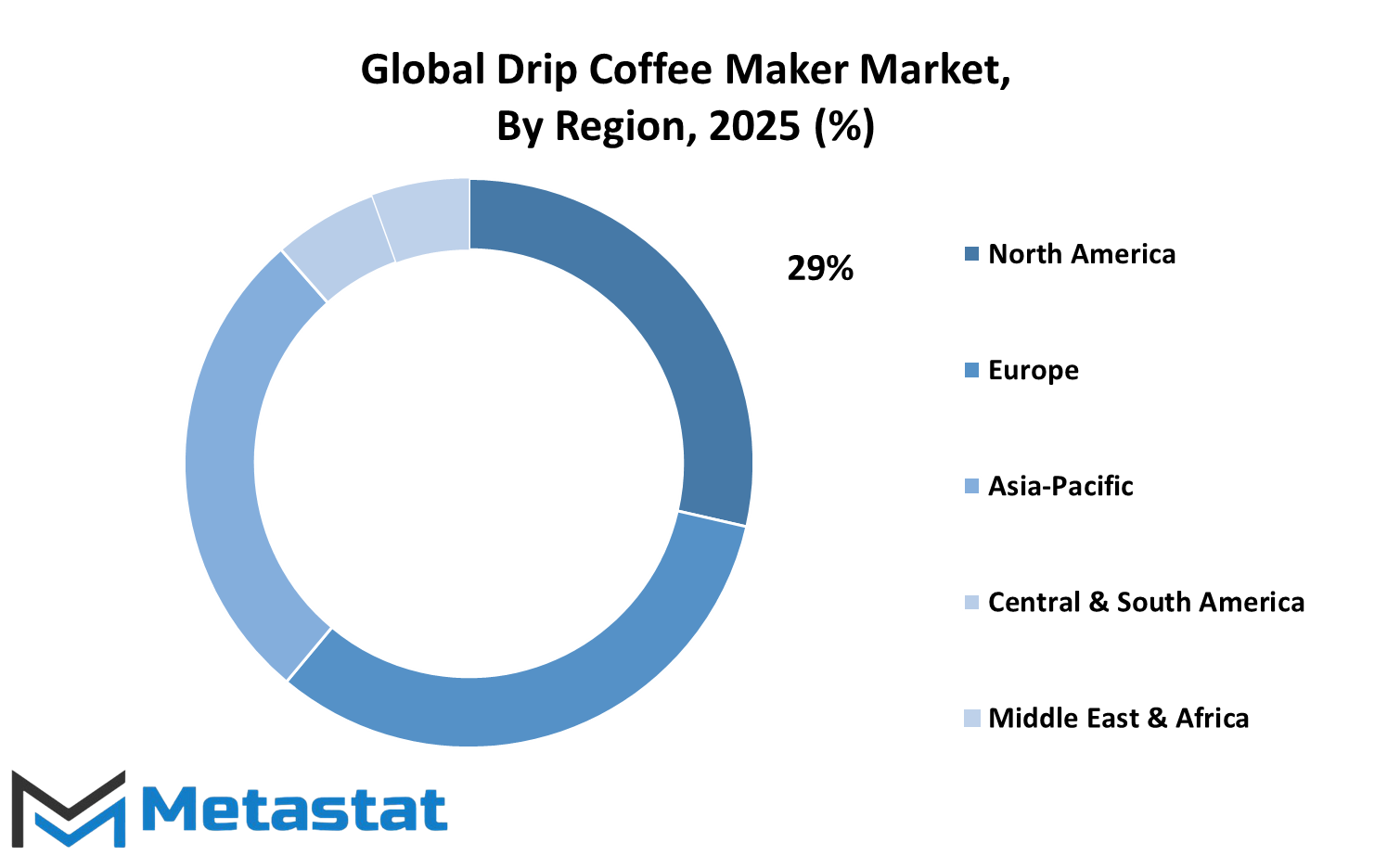MARKET OVERVIEW
Global Drip Coffee Maker market in consumer appliances will continue to evolve with coffee-brewing tastes getting more personalized and consumer needs shifting towards convenience and personalization. Between manual brew devices and high-end espresso makers, drip coffee brewers offer an efficient solution to make multiple cups of coffee effortlessly with minimal human intervention. Since the coffee consumption pattern varies geographically, manufacturers will include region-specific features, including programmable timers, adjustable brew strength, and thermal carafes for satisfying specific user requirements.
The Global Drip Coffee Maker market will revolve around the integration of smart technology, energy efficiency, and simplicity in product design. These appliances, widely used for their coffee preparation automation feature, are increasingly being developed for home as well as small commercial use. Improvements in filter technology, heaters, and water distribution systems will further improve extraction quality and brewing time. Products will be designed with ease-of-use interfaces and materials that provide durability, cleanliness, and aesthetic appeal, reflecting overall home and kitchen design trends.
Consumer behavior will drive the course of the Global Drip Coffee Maker market, especially as greater awareness of sustainability and health increases and translates directly into changing consumers' buying habits. Woke consumers will seek out models that reduce single-use plastics, consume less energy, and employ recyclable materials. And as consumers care more and more, makers will respond not just in terms of marketing but also in terms of making real changes in procurement, manufacturing, and distribution practices. The real coffee experience will be the priority, with more focus on how drip machines can deliver café-style coffee at home without much skill.
Regional differences in coffee usage habits will lead to specialty product adaptations across the Global Drip Coffee Maker market. In North America and Europe, larger-capacity units with programmable functions will dominate due to heavy domestic usage. In South America and Asia, however, devices of smaller capacity suited to smaller living spaces and quick brewing times will gain popularity. These variations will be considered in manufacturing and distribution strategies, with global brands balancing scale with local product innovation.
Technological convergence will remain the trend in shaping the trajectory of the Global Drip Coffee Maker market. Bluetooth connectivity, app control, and home automation system integration will be standard in mid-range to high-range models. Remote brewing activation, machine status observation, and maintenance notice capability will add value to customers seeking control as much as convenience. Not only will this variation distinguish products in a competitive marketplace, but it will enable companies to gain usage data for future improvement.
Regulatory specifications and safety conditions will also have an impact on the future of the Global Drip Coffee Maker market. The manufacturers will align with region-specific certifications, particularly with regard to electrical safety, food-grade quality, and energy efficiency. Such regulatory systems will affect production schedules, distribution strategies, and product labeling in foreign markets.
The Global Drip Coffee Maker industry will be dynamic because it will respond to technological progress, changing consumer demands, and competitive innovation. With brewing culture still diversifying, companies will look for new mechanisms to deliver value through performance, design, and user experience. This will define the manner in which drip coffee makers are designed, marketed, and adopted by various consumer bases across the world.
Global Drip Coffee Maker market is estimated to reach $3,385.32 Million by 2032; growing at a CAGR of 3.6% from 2025 to 2032.

GROWTH FACTORS
The Global Drip Coffee Maker market is consistently growing and will function well in the future. Increasingly, people around the world are using coffee not only as a beverage, but as a habit or even lifestyle. This trend is one of the reasons why the market is becoming more popular. As lifestyles change, and convenience is more of an issue, drip coffee makers are also gaining popularity within homes and offices. The convenience of brewing a great cup of coffee with minimal effort is attractive to individuals looking for quality but not devoting much time or energy. One of the most powerful growth drivers for the Global Drip Coffee Maker market is the increasing demand for home appliances that are convenient and save time.
With more people working from home or dividing their time between home and office, there is an increasing need for a good coffee maker. Also, there are increasing numbers of people interested in having coffee at home, which encourages them to spend on machines that can provide good results. Increasing numbers of small families and individual users also assist, as these machines are perfectly suitable for small kitchens and routine use.
Another key driver is the impact of new technology. As features of intelligence are being incorporated into appliances, drip coffee machines are also being upgraded to enhance the interaction between consumers and devices. Programmable options, temperature adjustment, and app-based functionalities are enhancing the appeal of such machines. As individuals become health conscious and cautious about what they intake, the capacity to regulate the strength and volume of coffee through such functions is a potent selling point.
But there are also a few things that can hinder the growth of the market. One of the problems is the presence of cheaper substitutes like instant coffee or simple manual processes, which a number of people continue to prefer because they are more affordable. Another problem is the fear about long-term upkeep and the cost to the environment of machines that consume electricity and plastic components. These issues cause potential buyers to hesitate.
Although there are these challenges, there remain numerous opportunities in the future. An increasing desire for sustainable and energy-efficient products provides an avenue for new designs that fulfill such requirements. With growing awareness and demand for eco-friendly products, businesses that prioritize such attributes will be successful. If companies keep innovating and emphasizing user-friendly, environmentally considerate designs, the Global Drip Coffee Maker market will provide numerous opportunities for growth in the future.
MARKET SEGMENTATION
By Type
The Global Drip Coffee Maker market is consistently advancing with the changing lifestyles and increasing interest in coffee brewed at home. Individuals are more inclined towards the experience of brewing their own coffee, be it through a fully automatic coffee maker or through a manual process. Both of them have their own charm, and each caters to different tastes. Automatic drip coffee makers find popularity with the convenience to use. Individuals prefer the ease of pushing a button and receiving a repeat brew each time. Conversely, manual choices provide greater control over the brewing process, which is appealing to those who like to be a part of each aspect of preparing their coffee.
The Global Drip Coffee Maker market by type, comprising both automatic and manual machines, is anticipated to hit USD 1,685.53 million. Much of this will be derived from the growing popularity of automatic machines. While this is the case, manual machines still maintain a consistent position owing to traditional appeal and control. As taste increases, manufacturers are providing more options with distinctive features and designs. Consumers are not only seeking function but also for designs that complement their kitchen and personality.
Consumer behaviors are evolving, and the emphasis is no longer on merely consuming coffee but on the pleasure of the brewing process. Both the drive for more complex automatic systems and interactive manual systems is met with this transition. New entrants enter the marketplace offering new concepts, and well-established players refine their products to remain competitive. All these indicate that the Global Drip Coffee Maker market will continue to grow steadily in the coming times.
As daily habits evolve and the concept of home comfort grows, the need for easy and personalized coffee-brewing experiences will keep on increasing. This consistent trend indicates a future where drip coffee makers will have an even larger presence in homes worldwide.
By Application
The Global Drip Coffee Maker market is likely to experience gradual but evident transformation in the coming years. With increasingly convenience-oriented daily routines, the demand for appliances that make life simpler is increasing. As one of the most commonly consumed drinks globally, coffee is playing a massive role in dictating this trend. Drip coffee makers, which are prized for their simplicity and capacity to make large volumes of coffee simultaneously, still remain a mainstay in households and businesses alike. That consistent demand suggests the market will continue to expand, although perhaps in new forms determined by future living and working habits.
In homes, individuals desire more than a simple appliance. Programmable timers, in-built grinders, and adjustable brewing strengths are becoming features. With more individuals working from home or on flexible schedules, being able to prepare high-quality coffee without having to leave the house has become increasingly significant. The change has driven more household buyers towards drip coffee makers that are perceived as an upgrade from previous ones. If this pattern persists, we are going to experience machines utilizing even more intelligent functions, potentially with integrated apps or automated filter ordering and bean systems.
At the business end, the Global Drip Coffee Maker market is changing as well. Offices, cafes, and hotels continue to depend on drip systems due to the fact that they can brew multiple cups at the same time and are convenient to use. Yet, there exists a greater necessity for machines which are not merely fast and trusty but are also energy conscious and can work under heavier loads of traffic with minimal breakdowns. Where quality cannot be forsaken despite an inability to manage time, drip coffee makers find a continued stronghold. More companies are also realizing how their appliances impact their operating expenses and the environment, so upcoming models will probably focus on being more efficient without compromising on the consistency of the coffee.
In the future, what is used domestically and what is used commercially might start to get blurred. Individuals want more from their appliances, and this pressure will probably prompt manufacturers to provide drip coffee makers that are flexible enough to accommodate various needs without complicating the process. As specialty coffee becomes more popular and as technology becomes simpler to incorporate into everyday products, drip coffee makers should quietly evolve and remain in sync with what consumers desire.
By Distribution Channel
The Global Drip Coffee Maker market will witness incremental changes over the years as habits, lifestyles, and shopping patterns continue to change. Coffee has transcended the status of being a beverage for many; it is a symbol of routine and comfort for them. As more individuals globally incorporate coffee into their daily lives, the demand for drip coffee makers will continue to increase. With improved technology and shifting customer behavior, this market will more than likely increase both in how the products are produced and the way they're sold.
In the future, the manner in which these coffee makers are purchased will have a significant role in defining the market. Distribution is largely divided into offline and online channels, with each having their own advantages. Offline outlets remain relevant for individuals who desire to view and try out a product before it is purchased. Having the option to ask questions in person, touch the item, and compare handsets side by side provides some consumers with reassurance. These shops will probably continue to have a role, particularly where consumers are not as accustomed to purchasing electronics on the internet or where online purchasing is still gaining confidence.
However, online purchasing has received increased attention in recent years and is set to be an increasingly influential channel in the future. With a few clicks, consumers can view numerous brands, read reviews, compare prices, and have their preference at their doorstep. Convenience, diversity, and better value on websites make them appealing. Where internet services are on the rise and smart phones are common, more individuals will move towards e-purchase. This shift will compel the manufacturers of drip coffee makers to make them more conspicuous and visible on online media.
Technology will also result in smarter and easier-to-use machines. Consumers will begin searching for things that enhance their experience, like fast brewing times, energy-saving capabilities, and simpler cleaning. In order to stay on top of such changes, both online and offline retailers must do more than sell the product they must deliver support, transparent information, and quality customer service.
As routines evolve and consumers search for convenient, efficient methods of getting their coffee, the Global Drip Coffee Maker market will evolve. When someone visits a store or navigates products on their mobile phone, convenience, quality, and trust will be the defining elements of the future of this market.
|
Forecast Period |
2025-2032 |
|
Market Size in 2025 |
$2,642.10 million |
|
Market Size by 2032 |
$3,385.32 Million |
|
Growth Rate from 2025 to 2032 |
3.6% |
|
Base Year |
2024 |
|
Regions Covered |
North America, Europe, Asia-Pacific, South America, Middle East & Africa |
REGIONAL ANALYSIS
The Global Drip Coffee Maker market will still display significant changes according to geography as consumer trends, economic development, and lifestyle also affect local demand. Various regions have their own needs and expectations regarding how coffee should be made and consumed. While convenience and speed drive some areas, others are increasingly quality- and flavor-driven. As we continue into the future, these variations will dictate how our market expands in each region.
The North American market, composed of the U.S., Canada, and Mexico, will most probably continue to play a significant part in the market. The culture in the U.S. and Canada, in particular, is accustomed to having coffee on a daily basis. Consumers in these nations are willing to accept newer machines with more control and features, and that will encourage firms to innovate. In contrast, Mexico demonstrates increased interest in new appliances, and that can unlock new opportunities for manufacturers of entry-level or mid-range drip coffee makers.
In Europe, the UK, Germany, France, Italy, among others, coffee still features as a significant aspect of daily life. European consumers value both function and design, thus lending consistent interest in machines with both. Germany and France will continue to purchase solid and efficient models, while Italy influences the market through coffee culture. Overall, the region will likely underwrite demand for energy-efficient machines and small formats, particularly as city living continues to become more prevalent.
The Asia-Pacific region, which includes nations such as India, China, Japan, and South Korea, is a promising market for future growth. Increasing incomes, shifting work trends, and an increasing youth population will ensure that the demand for drip coffee makers increases. As coffee gains popularity among consumers who have traditionally been tea drinkers, there is an opportunity for makers to access a heightened pool of first-time buyers. Specifically, India and China are warming up to in-home brewing of coffee, which previously used to be unusual in these regions.
South America, particularly Brazil and Argentina, can expect steady growth due to the region's high correlation with coffee production. Though individuals in this region tend to stick with conventional brewing, there is growing interest among younger consumers in quicker and easier methods of preparing the beverage. That trend can contribute to higher sales in the next few years.
In the Middle East and Africa, developing urban areas and greater exposure to international trends are altering the way people consume coffee. The GCC group, Egypt, and South Africa are becoming significant hub points for growth where drip coffee makers can rise in popularity over time.

COMPETITIVE PLAYERS
The Global Drip Coffee Maker market will experience slow but consistent transformations as consumer trends change, and newer technology becomes increasingly prevalent in everyday appliances. Individuals are demonstrating a greater affinity for convenience, quality, and style, which is subtly influencing how drip coffee makers are designed and marketed. The shift towards home brewing, fueled by increased interest in café-style experiences at home, will continue to pressure companies to innovate without making the machines overly complicated for daily use.
Competitive players in this market have already begun to shift their strategies to address evolving needs. Companies like Koninklijke Philips N.V., Moccamaster, and Bonavita are more inclined to develop machines that perform more than just coffee brewing. Their devices are starting to take into consideration what the modern consumer cares about—such as energy efficiency, cleaning ease, and durability over the long haul. Some of these companies are playing around with user-friendly features that allow the consumer to get just the right amount of strength or temperature of brew, without making it feel too technical.
Mr. Coffee, Capresso, and Cuisinart are names that have been household standards for decades. They are also heading towards models that integrate well with home interior and occupy minimal space on the countertops. The companies are also going to come up with models that will be compatible with smart home systems. In the coming days, it might be that preparing a cup of coffee is just a matter of voice instruction or a single touch on the phone screen. It is probable that machines will provide reminders for maintenance, monitor use, and propose settings based on user patterns.
At the same time, other firms such as De'Longhi Appliances S.r.l. and Electrolux AB will place more emphasis on performance and aesthetics, attempting to differentiate themselves by combining functionality with appearance. Shark Ninja and OXO could continue to innovate by providing drip as well as other brewing types in a single machine, creating greater value without requiring separate appliances.
Companies like Ratio, AGARO, and Ariete might try to stake out their niche by having models at multiple price points yet fulfilling increasing demand for quality and durability. With the market in ongoing transition, every participant will need to be attentive to what users are seeking and continue making modifications to their designs. In due course, the Global Drip Coffee Maker market will demonstrate a combination of tradition and innovative thinking.
Drip Coffee Maker Market Key Segments:
By Type
- Automatic
- Manual
By Application
- Residential
- Commercial
By Distribution Channel
- Offline
- Online
Key Global Drip Coffee Maker Industry Players
- Koninklijke Philips N.V.
- Moccamaster
- Bonavita
- Mr. Coffee
- Capresso
- Cuisinart
- De’Longhi Appliances S.r.l.
- Electrolux AB
- Shark Ninja
- OXO
- Ratio
- AGARO
- Ariete
WHAT REPORT PROVIDES
- Full in-depth analysis of the parent Industry
- Important changes in market and its dynamics
- Segmentation details of the market
- Former, on-going, and projected market analysis in terms of volume and value
- Assessment of niche industry developments
- Market share analysis
- Key strategies of major players
- Emerging segments and regional growth potential








 US: +1 3023308252
US: +1 3023308252






